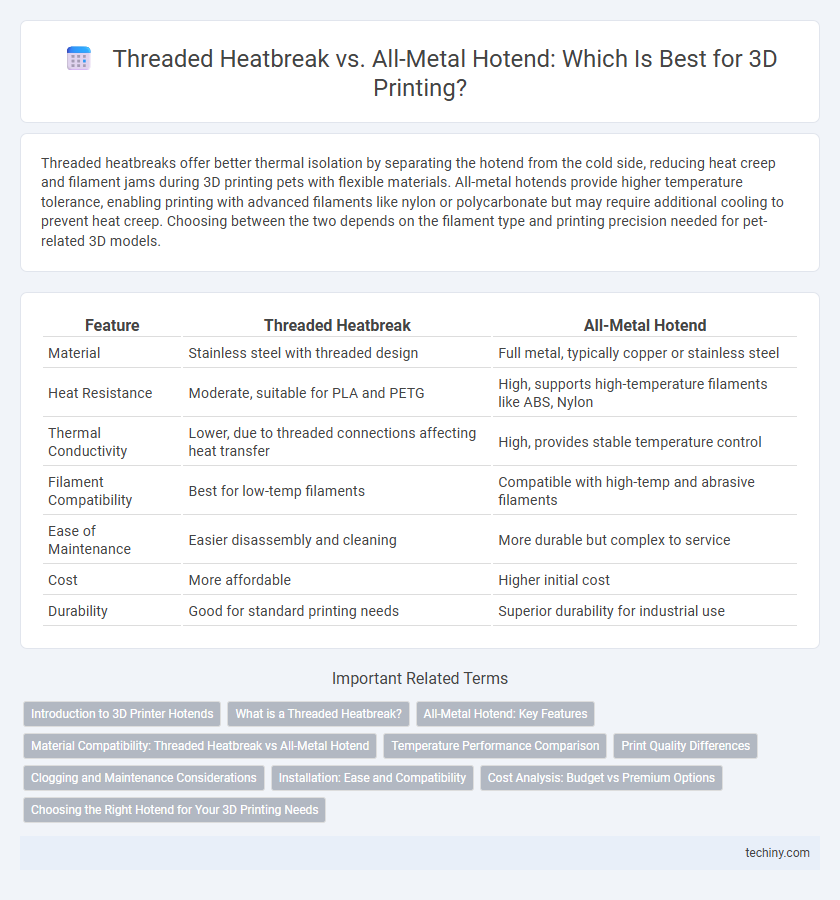Threaded heatbreaks offer better thermal isolation by separating the hotend from the cold side, reducing heat creep and filament jams during 3D printing pets with flexible materials. All-metal hotends provide higher temperature tolerance, enabling printing with advanced filaments like nylon or polycarbonate but may require additional cooling to prevent heat creep. Choosing between the two depends on the filament type and printing precision needed for pet-related 3D models.
Table of Comparison
| Feature | Threaded Heatbreak | All-Metal Hotend |
|---|---|---|
| Material | Stainless steel with threaded design | Full metal, typically copper or stainless steel |
| Heat Resistance | Moderate, suitable for PLA and PETG | High, supports high-temperature filaments like ABS, Nylon |
| Thermal Conductivity | Lower, due to threaded connections affecting heat transfer | High, provides stable temperature control |
| Filament Compatibility | Best for low-temp filaments | Compatible with high-temp and abrasive filaments |
| Ease of Maintenance | Easier disassembly and cleaning | More durable but complex to service |
| Cost | More affordable | Higher initial cost |
| Durability | Good for standard printing needs | Superior durability for industrial use |
Introduction to 3D Printer Hotends
Threaded heatbreaks provide enhanced thermal isolation by reducing heat transfer between the hotend and coldend, which improves print quality and reduces filament jams in 3D printers. All-metal hotends, constructed entirely of metal, enable higher temperature printing with materials like ABS, PETG, and Nylon but may require cooling solutions to prevent heat creep. Understanding the differences in heatbreak design and hotend material composition is crucial for selecting the right hotend to optimize extrusion performance and material compatibility in 3D printing.
What is a Threaded Heatbreak?
A threaded heatbreak is a crucial component in 3D printer hotends designed to connect the heat sink and heater block securely, featuring threaded sections that allow for precise assembly and easy maintenance. It typically incorporates a stainless steel or titanium tube with fine threading to reduce heat transfer between the hot and cold zones, improving thermal isolation and print quality. This design contrasts with all-metal hotends by offering enhanced thermal management and compatibility with various filament types, minimizing heat creep during high-temperature printing.
All-Metal Hotend: Key Features
All-metal hotends feature a full metal heatbreak that enables printing at higher temperatures up to 300degC or more, allowing compatibility with advanced filaments such as polycarbonate, nylon, and carbon fiber composites. They offer superior thermal conductivity and stability, reducing heat creep and improving print quality by maintaining a consistent melt zone. Enhanced durability and corrosion resistance make all-metal hotends ideal for extended use and demanding applications in industrial and hobbyist 3D printing.
Material Compatibility: Threaded Heatbreak vs All-Metal Hotend
Threaded heatbreaks typically utilize a combination of stainless steel and PTFE liners, offering excellent compatibility with PLA, PETG, and other low-temperature filaments by preventing heat creep. All-metal hotends, constructed entirely from metals like stainless steel or titanium, support high-temperature filaments such as ABS, nylon, and polycarbonate by withstanding temperatures above 300degC without degrading. Selecting between the two depends on the filament's thermal requirements and desired print quality, with all-metal hotends providing broader material versatility.
Temperature Performance Comparison
Threaded heatbreaks in 3D printers typically offer better thermal isolation, maintaining a cooler upper section to prevent heat creep and improve print quality at high temperatures. All-metal hotends excel in high-temperature resilience, supporting materials like polycarbonate and nylon by withstanding heat above 300degC without degrading. Temperature performance comparison reveals that threaded heatbreaks balance cooling efficiency and heat transfer, while all-metal hotends provide superior durability for industrial-grade temperature demands.
Print Quality Differences
Threaded heatbreaks often improve thermal isolation between the hotend and coldend, reducing heat creep and preventing filament jams, which enhances print quality in materials sensitive to heat. All-metal hotends excel at higher temperature printing and enable printing with a wider range of filaments like ABS and polycarbonate, but may risk more heat creep if the heatbreak design lacks proper thermal isolation. Print quality differences manifest as more consistent extrusion and fewer clogs with threaded heatbreaks in low-temperature filaments, while all-metal hotends enable superior layer adhesion and strength in high-temp filaments despite requiring fine-tuned cooling management.
Clogging and Maintenance Considerations
Threaded heatbreaks in 3D printing often require more frequent maintenance due to increased clogging risks caused by filament residue accumulating in the threaded interface. All-metal hotends minimize clogging by providing a seamless thermal barrier and better heat dissipation, reducing filament degradation and jams. Regular inspection and cleaning are essential for threaded heatbreaks to maintain optimal extrusion performance and prevent downtime.
Installation: Ease and Compatibility
Threaded heatbreaks offer straightforward installation with compatibility across various hotend models due to standardized threading, simplifying upgrades and replacements. All-metal hotends often require precise fitting and calibration, which can extend setup time but provide robust performance under high temperatures. Users prioritizing quick assembly and modularity benefit from threaded heatbreak designs, while those needing durability and extreme heat resistance may favor all-metal hotends despite a more involved installation process.
Cost Analysis: Budget vs Premium Options
Threaded heatbreaks typically offer a cost-effective solution for 3D printing hotends, making them ideal for budget-conscious users seeking reliable performance without high investment. All-metal hotends, while more expensive, provide superior thermal durability and support for higher temperature materials, delivering enhanced print quality and longevity. Evaluating your printing needs against cost reveals that budget options suffice for PLA and basic filaments, whereas premium all-metal hotends are justified for advanced polymers and frequent use.
Choosing the Right Hotend for Your 3D Printing Needs
Choosing the right hotend for your 3D printing project depends on factors like material compatibility, temperature control, and durability. Threaded heatbreak hotends offer reliable thermal isolation and are ideal for printing with PLA and other low-temperature filaments. All-metal hotends support higher temperature materials such as PETG, ABS, and nylon, providing greater versatility for advanced printing applications and enhanced extrusion consistency.
Threaded Heatbreak vs All-Metal Hotend Infographic

 techiny.com
techiny.com